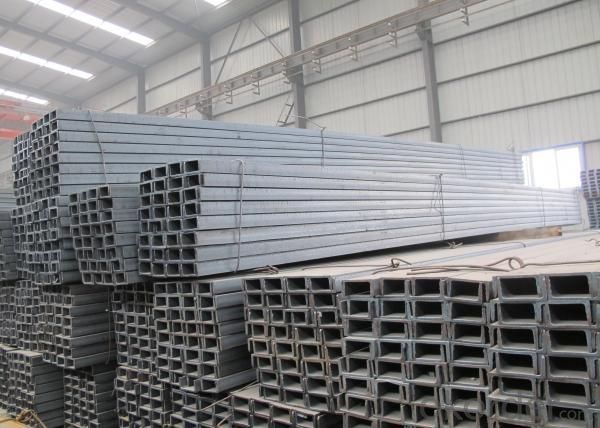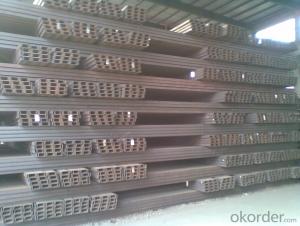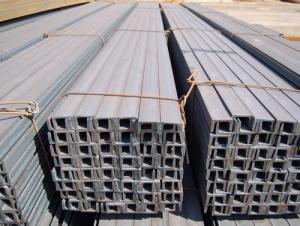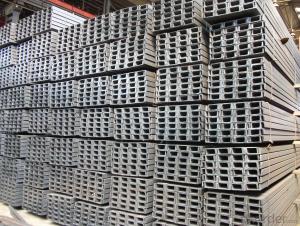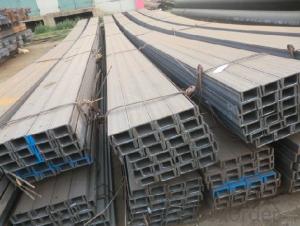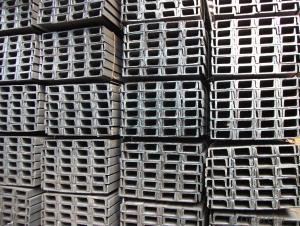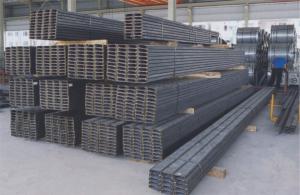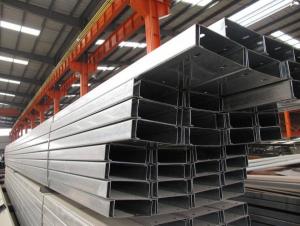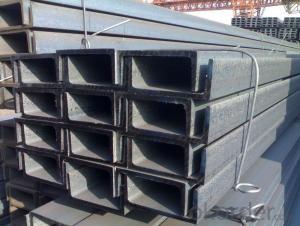Channels UPE
- Loading Port:
- Xingang Port
- Payment Terms:
- TT or LC
- Min Order Qty:
- 25 tons m.t.
- Supply Capability:
- 80000-100000MTS/YEAR m.t./month
OKorder Service Pledge
OKorder Financial Service
You Might Also Like
Specifications of UPE Channels:
1.Our UPE Channels has lots of advantages, just as followings:
a) At reasonable price and good quality.
b) To be convenient in construction and to save much time and labor.
c) The length of UPE channels can be manufactured according to customer’s requirements.
d) The UPE Channels has strong mechanical strength.
e). The UPE Channels possesses various kind of fittings, through which it is suitbal for many combinations.
f) Our UPE Channels is attractive in appearance as well as beautiful in design
g) Free from slotted and characterised for plain surface
|
Grade |
S235JR |
|
Dimension |
80-200mm |
|
Place of origin |
Hebei,China(Mainland) |
|
Brand Name |
UINDA |
|
Technic |
Hot Rolling |
2. The detailed sections of our UPE Channels can be found in table-1
|
UPE CHANNELS |
Standard h |
Sectional b |
Dimension s |
t |
Mass: Kg/m |
|
|
(mm) |
(mm) |
(mm) |
(mm) |
|
|
80x45 |
80 |
45 |
6.0 |
8.0 |
8.64 |
|
100X50 |
100 |
50 |
6.0 |
8.5 |
10.6 |
|
120x55 |
120 |
55 |
7.0 |
9.0 |
13.4 |
|
140x60 |
140 |
50 |
7.0 |
10.0 |
16.0 |
|
160x65 |
160 |
65 |
7.5 |
10.0 |
18.8 |
|
180x70 |
180 |
70 |
8.0 |
11.0 |
22.0 |
Table-1
Note: we are definitely good at manufacturing and supplying UPE channel steel as per S235JR. Also, we are willing and able to provide our customers UPE channel steel in other sizes, which depends on customers’ concret requirements for the quantity.
3. The chemical composition of UPE Channel Steel as per S235JR is shown in the table-2
|
Alloy No |
Element(%) | ||||
|
C |
Mn |
S |
P |
Si | |
|
S235JR |
0.12—0.20 |
0.3—0.7 |
≤0.030 |
≤0.030 |
≤0.20 |
Table-2
4. The mechanical property of UPE Channels as per S235JR is shown in the table-3-1 and table-3-2
|
Alloy No |
Yielding strength point( Mpa) | |||
|
Thickness (mm) | ||||
|
≤16 |
>16--40 |
>40--60 |
>60--100 | |
|
≥ | ||||
|
S235JR |
235 |
225 |
215 |
195 |
Table-3-1
|
Alloy No |
Tensile strength (Mpa) |
Elongation after fracture(%) | |||
|
Thickness (mm) | |||||
|
|
≤16 |
>16--40 |
>40--60 |
>60--100 | |
|
≥ | |||||
|
S235JR |
340--510 |
24 |
23 |
22 |
27 |
Table-3-2
Applications of UPE Channels:
The UPE Channels can be applied to construction of warehouses, workshops, sport stadiums and car parks etc.The hot rolled channel steel belongs to carbon structural steel which is applied to in the field of construction and machinery.In details, the hot rolled channel steel is usually used for arch-itechtural structure, and they could be welded in order to support or hang a vari-ety of facilities. They are also usually used in combination with I beam. Generally,the hot rolled channel steel we supply must possess perfect welding property, riveting property and mechanical property and so on.
Package & Delivery of UPE Channels:
1.The UPE channels will be packed in bundle with steel wire at each end of every bundle and color marking in order to help the customer to recognize his goods more easily at sight.
2. And the UPE channels could be loaded into 20ft or 40ft container, or by bulk cargo.If the weight of each bundle reaches more than 3.5 mt, the loading by break bulk cargo should be choosed.When the weight of each bundle reaches less than 3mt, the loading by container should be choosed.
3.As for the transportaion from mill to loading port, the truck will be usually used. And the maximum quantity for each truck is 40mt.
4.All in all, we could do in accordance with customer's request.
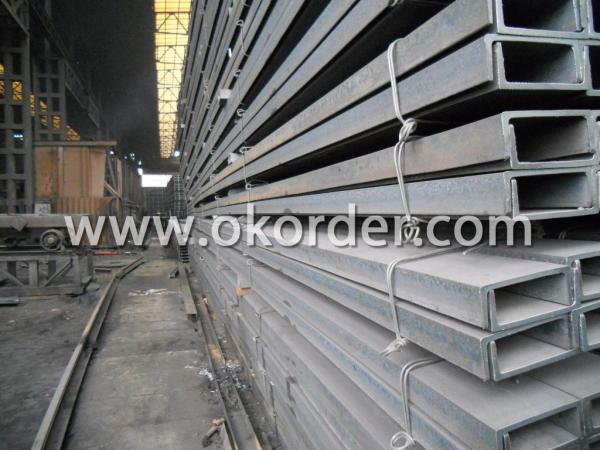
Production Flow of UPE Channels:
1.The steel billet shall be heated in the high temperature furnace.
2. The heated steel billet shall be rolled five to nine times with the aim of shaping the general figure of steel u channel.
3. The rolled steel u channel should be put onto the cooling bed to make the temperature low.
4. The steel u channel should be straighted on the straightener.
5. The straighted steel u channel will be cut into meters by saw, as per customer's requirements.
6. At the last part of production, the channel steel must be tested in order to confirm that the finished products are completely free from crack, pore, slag, scab or fold on the surface.
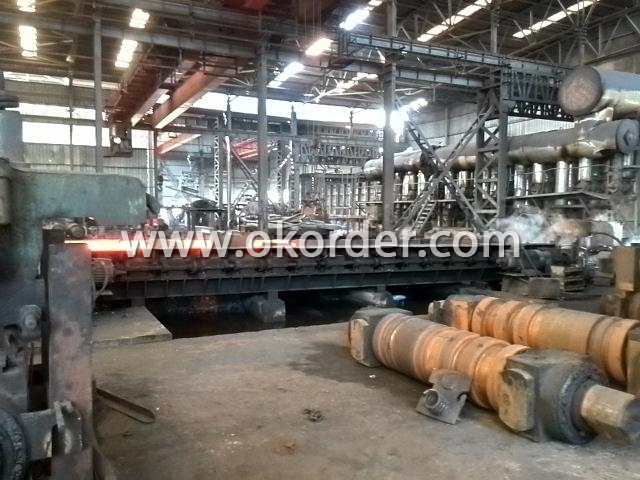
- Q: What are the different spans achievable with steel channels?
- The spans achievable with steel channels can vary depending on various factors such as the size and shape of the channel, the load it needs to support, and the design considerations. Steel channels are commonly used in construction and engineering projects for structural support and reinforcement. For smaller steel channels, typically known as C-channels, the spans achievable can range from a few feet to several tens of feet. These channels are often used for light-duty applications such as framing, bracing, and supporting smaller loads. On the other hand, larger steel channels, such as I-beams or H-beams, can achieve much larger spans. These channels are designed to support heavier loads and provide structural integrity over longer distances. The spans achievable with these channels can range from tens of feet to several hundred feet or even more, depending on the specific design and engineering requirements. It is important to note that achieving longer spans with steel channels often requires additional engineering considerations such as proper calculations for load distribution, the use of appropriate connections and fasteners, and adherence to local building codes and regulations. Consulting with a structural engineer or a professional in the field is highly recommended to ensure the safe and effective use of steel channels for achieving desired spans in any construction or engineering project.
- Q: What are the different welding methods for steel channels?
- There are several different welding methods that can be used for steel channels, depending on the specific application and desired results. Some of the most common welding methods for steel channels include: 1. Shielded Metal Arc Welding (SMAW): Also known as stick welding, SMAW involves using an electrode coated in flux to create an arc between the electrode and the base metal. This method is versatile and can be used for both thick and thin steel channels, making it suitable for a wide range of applications. 2. Gas Metal Arc Welding (GMAW): Commonly referred to as MIG welding, GMAW uses a continuous wire electrode that is fed through a welding gun. The wire is melted and joined with the base metal while being shielded by a gas, typically a mixture of argon and carbon dioxide. This method is known for its speed and efficiency, making it ideal for high-volume production of steel channels. 3. Flux-Cored Arc Welding (FCAW): Similar to GMAW, FCAW utilizes a continuous wire electrode, but instead of using a shielding gas, it uses a flux-filled tubular wire. This flux creates a protective shield around the weld, eliminating the need for an external gas supply. FCAW is commonly used for outdoor applications or in environments with strong drafts that could blow away the shielding gas. 4. Gas Tungsten Arc Welding (GTAW): Also known as TIG welding, GTAW uses a non-consumable tungsten electrode to create an arc and heat the base metal. A separate filler rod is then manually fed into the weld pool, creating the joint. GTAW is known for its precision and control, making it suitable for welding thin steel channels or when a high-quality weld is required. 5. Submerged Arc Welding (SAW): SAW involves feeding a continuous wire electrode into the joint while a layer of granular flux covers the weld zone. The arc is submerged beneath the flux, providing a protective atmosphere and preventing the weld from being exposed to the surrounding air. This method is commonly used for thicker steel channels or when high deposition rates are required. It is important to consider the specific requirements of the steel channel and the intended application when selecting a welding method. Each method has its advantages and limitations, so it is crucial to choose the most appropriate method for achieving the desired results in terms of strength, aesthetics, and efficiency.
- Q: Can steel channels be used in outdoor environments?
- Yes, steel channels can be used in outdoor environments. Steel is a durable and weather-resistant material, making it suitable for various outdoor applications such as construction, infrastructure, and outdoor structures. It can withstand harsh weather conditions, including rain, snow, and extreme temperatures, without rusting or deteriorating easily. Additionally, steel channels can be galvanized or coated with protective coatings to enhance their resistance to corrosion and extend their lifespan in outdoor environments.
- Q: What are the standard sizes for steel channels?
- The standard sizes for steel channels vary depending on the country and industry standards. In the United States, the American Standard Steel Channels (C-shapes) are available in a range of sizes, typically designated by the depth of the channel in inches and the weight per foot. Common sizes include 3x4.1, 3x5.0, 3x6.0, 4x5.4, 4x7.25, and 6x12.5. These sizes are widely used in construction, manufacturing, and structural applications. In other countries, different size standards may be followed. For example, in the United Kingdom, steel channels are often specified using the European standard designation, such as C100x50x10. This designation represents the depth (100 mm), width (50 mm), and weight per meter (10 kg/m) of the channel. It is important to note that these are just a few examples of standard sizes, and there are numerous other sizes available depending on specific requirements and applications. As such, it is recommended to consult relevant industry standards or manufacturers' catalogs for comprehensive information on steel channel sizes.
- Q: How do steel channels differ from steel angles?
- Structural steel shapes include steel channels and steel angles, which vary in shape and usage. Steel channels are beams shaped like the letter "C" with a perpendicular web connecting the flanges. They are primarily utilized for structural support in construction projects, providing additional strength and stability to beams, columns, and other structures. Bridges, buildings, and infrastructure projects commonly employ channels. On the other hand, steel angles are beams shaped like the letter "L" with two legs perpendicular to each other. They serve as structural support and reinforcement and have a wide range of applications such as framing, bracing, and supporting various structures. Construction, manufacturing, and fabrication industries commonly use angles. Channels possess a rounded, curved appearance, while angles have a sharp corner where the legs intersect. This distinction in shape results in different mechanical properties and load-bearing capacities. Furthermore, steel angles offer greater flexibility in connecting and joining structural components due to their right-angle shape. They can be easily welded, bolted, or fastened together to create different structures. In contrast, channels are more often used as independent structural elements and have less versatility in connecting with other components. In conclusion, steel channels and steel angles vary in shape, application, and versatility. Channels primarily provide support and reinforcement, while angles offer flexibility in joining and connecting various components. Both shapes play vital roles in the construction and manufacturing industries, contributing to the strength and stability of structures.
- Q: Are steel channels available in different colors?
- No, steel channels are typically only available in their natural silver color.
- Q: Do steel channels require any special maintenance?
- Yes, steel channels require regular maintenance to ensure their longevity and performance. This includes periodic cleaning to remove dirt, debris, and rust, as well as inspection for any signs of damage or corrosion. Applying protective coatings or paints can also help prevent further rusting and deterioration. Additionally, proper storage and handling should be followed to avoid any bending or warping of the channels.
- Q: Are steel channels suitable for the mining parts manufacturing industry?
- Yes, steel channels are suitable for the mining parts manufacturing industry. Steel channels offer high strength and durability, making them ideal for withstanding the harsh conditions and heavy loads often encountered in the mining industry. Additionally, steel channels can be easily fabricated and customized to meet specific design requirements, making them a versatile choice for manufacturing various mining parts and components.
- Q: What are the different methods of strengthening steel channels?
- There are several methods used to strengthen steel channels, including heat treatment, cold working, and alloying. Heat treatment involves subjecting the steel to high temperatures and then cooling it rapidly, which alters its microstructure and increases its strength. Cold working, on the other hand, involves deforming the steel at room temperature through processes like rolling or drawing, which also enhances its strength. Alloying refers to adding other elements to the steel, such as carbon or chromium, to improve its properties and make it stronger.
- Q: Can steel channels be used for supporting HVAC systems?
- Yes, steel channels can be used for supporting HVAC systems. Steel channels are typically made of durable and strong steel material, making them suitable for providing structural support to HVAC equipment. They are often used in conjunction with other support materials, such as brackets and hangers, to securely hold and suspend HVAC units, ductwork, and piping. Steel channels offer several advantages for supporting HVAC systems. Firstly, they have high load-bearing capacity, ensuring that the weight of the HVAC equipment and components is adequately supported. Additionally, steel channels are resistant to corrosion and can withstand harsh environmental conditions, making them suitable for both indoor and outdoor applications. Steel channels also provide flexibility in terms of installation. They can be easily adjusted and customized to accommodate different HVAC system configurations. Moreover, steel channels can be installed using various methods, such as welding, bolting, or clamping, offering versatility in the installation process. It is important to ensure that the steel channels used for supporting HVAC systems are designed and installed according to industry standards and local building codes. Proper engineering and design considerations, including load calculations, seismic requirements, and thermal expansion, should be taken into account to ensure the safety and stability of the HVAC system. Overall, steel channels are a reliable and commonly used method for supporting HVAC systems, providing strength, durability, and flexibility in installation.
1. Manufacturer Overview
| Location | Tangshan, China |
| Year Established | 2000 |
| Annual Output Value | Above US$ 50 Million |
| Main Markets | Mid East; Southeast Asia; Korea |
| Company Certifications |
2. Manufacturer Certificates
| a) Certification Name | |
| Range | |
| Reference | |
| Validity Period |
3. Manufacturer Capability
| a) Trade Capacity | |
| Nearest Port | Tianjin |
| Export Percentage | 20% - 30% |
| No.of Employees in Trade Department | 10-20 People |
| Language Spoken: | English; Chinese |
| b) Factory Information | |
| Factory Size: | Above 81,000 square meters |
| No. of Production Lines | 1 |
| Contract Manufacturing | OEM Service Offered |
| Product Price Range | Average |
Send your message to us
Channels UPE
- Loading Port:
- Xingang Port
- Payment Terms:
- TT or LC
- Min Order Qty:
- 25 tons m.t.
- Supply Capability:
- 80000-100000MTS/YEAR m.t./month
OKorder Service Pledge
OKorder Financial Service
Similar products
Hot products
Hot Searches
Related keywords



